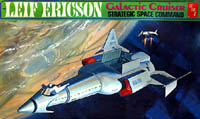


What's inside? Who knows. From Frank Henriquez masterful analysis we know that the Leif plastic model is 1/500 scale. According to the Leif Ericson Blueprints, the model is 13.194 inches or 0.33513 meters long. This means that the actual ship is 500 times that, or 167.57 meters long, and the deck spacing is 3.5 meters (11.4 ft). The only thing we know about the interior is the size of the hanger bay, and the deck spacing (from the windows).
With a 3-D computer mesh model in a program called Lightwave, a plug in called AreaVolume can be used. The computer model is 12.46 meters long. The Length Scaling Factor is 167.57 / 12.46 = 13.45. This implies that the Volume Scaling Factor is 13.45^3 or 2433.14.
AreaVolume calculated that the computer mesh's total internal volume is 28.27 cubic meters, command boom volume is 1.54 cubic meters, and the body volume (without wings or nacelles) is 17.84 cubic meters. Multiplying by the Volume Scaling Factor 2433.14 gives us:
Be advised that I have been known to make childish mistakes in arithmatic, so you would be wise to double-check my calculations.
The hangar bay is roughly 20 meters wide by 30 meters long by 11 meters deep, or approximately 6,600 cubic meters. I say "approximately" since the walls are sloped and the roof is curved.
I had been doing some speculation on my own. This is all theoretical on my part. Refer to the image above. Here is my reasoning:
Keep in mind that the tube down the center of the goose-neck is not a hollow tube for the beam to travel down. The tube is the Laser Generator. With lasers, the longer the column of energized lasing medium the beam traverses, the more powerful the beam becomes. Here the column is almost the entire length of the goose-neck. The generator is probably some species of free-electron laser.
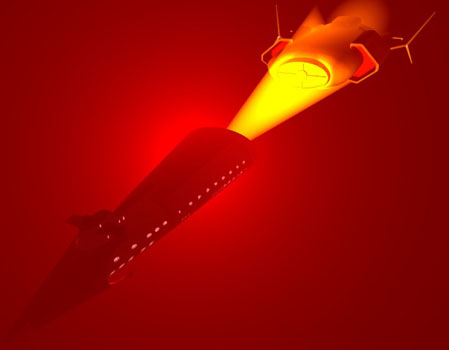
Another interesting possibility is suggested by the band where the goose-neck in front attaches to the body of the ship, where the ship's "shoulders" are. In Star Trek, the saucer section of the starship Enterprise can separate from the rest of the ship in emergencies. In the game Star Fleet Battles, it is alleged that on the Klingon Battlecruisers, their goose-necks can separate from the rear section in much the same way. So it is possible that the Leif's goose-neck can also separate, and act as a titanic sub-light lifeboat.
We will ignore Jim Cambias, who points out that in an emergency, the logical thing is don't eject the crew in pods, EJECT THE REACTOR! Totally scientific, but it is so much more exciting to do a boom separation.
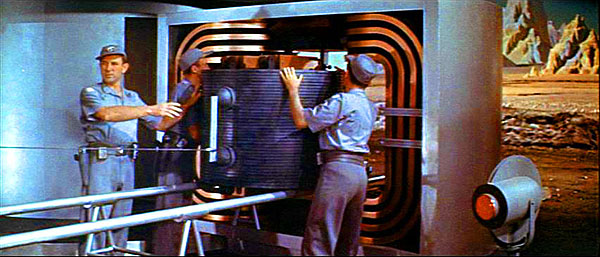
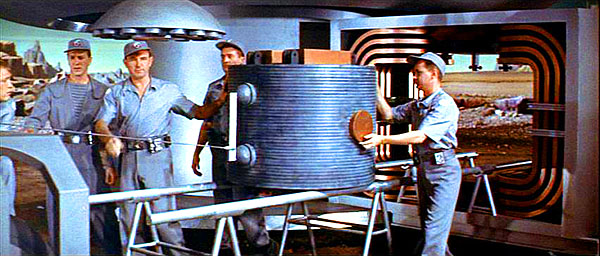
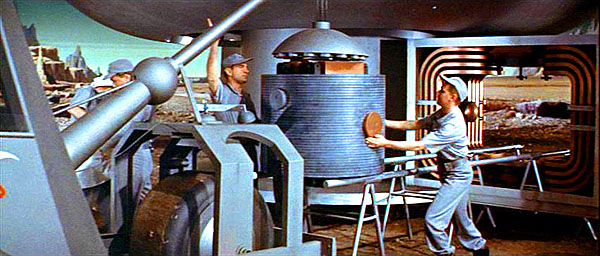
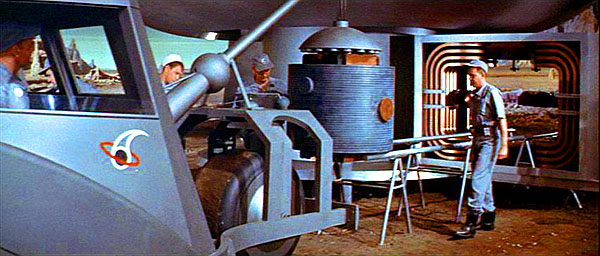
Another thing you might want to think about, based on my naval engineering days: how big are the biggest parts in the engineering spaces? That is, what's the size of the biggest thing you might have to move in and out of the craft for repairs or replacement? The radiators are already on the outside. Are there reactor vessels, fusion containment cells, or some other nifty big bits that cannot be broken down into smaller parts? How about tanks (for algae, fuel, water, sewage, recycling, air)? You're going to need a way to get that stuff on and off, and a way to handle the large mass safely.
This is a special worry since the Leif Ericson will often be all alone on a wilderness planet, with no local facilities to help. Christopher Weuve suggested gantry cranes and portainers.
I'm thinking that one would want some sort of crane over the hangar bay, to move the auxiliary ships around. If the crane was located in one of the front corners of the hangar bay, it could not only service the bay, but it could rotate over the fusion reactor, lift it out, and lower it onto the ground.
What else is inside? There are some suggestions to spark your imagination here. Off the top of my head:
There will have to be heat radiators on the hull or the wings. There is a ridged area on the underside of the goose-neck that could be a radiator. The open housings around the glowing red propulsion units could also act as "fuel scoops". This would allow the Leif to dive into the atmosphere of a gas giant planet and collect hydrogen fuel for the fusion reactor. The ability to refuel in the wilderness is a good feature for a long range exploration craft.
Some kind of artificial gravity is indicated, for two reasons. First off, this ship has the bad old "Jules Verne" arrangement, where "down" is perpendicular to the direction of travel. This requires some kind of artificial gravity.
But more importantly, the canon short story shipped with the plastic model mentions that the Leif can land and take-off from a planet. Without antigravity or other non-rocket propulsion, the only way something as huge as the Leif is going to lift off is with an incredibly powerful and destructive rocket exhaust that will make a Saturn-V look like a bottle-rocket.